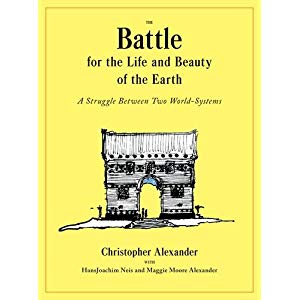Å stå alene i kampen for liv og skjønnhet på jorden, er selvsagt tøft. Jeg er den siste på Toten som verdsetter arven etter våre forfedre, og står alene i kampen mot hesligheten, sammen med en håndfull andre mennesker i vårt land. Staten er en voldsom fiende av all skjønnhet og alt som gjør livet verdt å leve, og utdanner arkitekter og teknokrater med eneste formål å drepe livet, skjønnheten og håpet. På Grythengen, hvor min slekt har vært i sju generasjoner, har de lyktes overmåte godt!
Men med Alexanders kampskrift under armen skal jeg stå på til den visse død, selv om jeg ikke ser en eneste strime av håp for vårt land.
Read the original review here.
***
SYNOPSIS
Christopher Alexander is an architect and builder. He taught at Berkeley for many years and his work goes beyond the domain of architecture, he studies the nature of aesthetics and one might even say the metaphysics of how beautiful places can connect us to the divine. If all that sounds too ethereal for the practical man remember that Alexander is not an ivory tower architect, he’s also a builder who trudges through muddy fields, mixes cements, and applies his hand to painting details.
The ‘Battle’ in his book took place when he built the Eishen campus near Tokyo: a high school campus of more than a dozen buildings and a small artificial lake. I have visited Eishen; it’s a lovely peaceful place, and it is hard to believe its creation invoked a battle involving giant construction companies, boardroom backstabbing, betrayal and even the Yakuza.
At the heart of the battle was his approach to building. Most building projects are fairly mechanical and capitalistic. An architect designs something in great detail on paper and then they pass it to a construction firm that attempts to complete the design as accurately (and as cheaply) as possible. All the thinking is done in the design stage, the builder is just a ‘pair of hands’ to execute it. Alexander’s approach is to work from drawings to mock-ups to the building itself. His approach allows for constant tweaking of the design to create something wonderful that works as a whole. The thinking never stops since it is impossible to know the right answers until you are deep in construction and what is working and not working has become clear. He calls this adaptive approach System A, and the mechanistic one System B.
LESSONS FOR MANAGEMENT
Managers should understand these two fundamental modes of approaching work and how deeply they conflict. System A seems so sensible that one wonders who would oppose it. However, the world we live in often does operate where one person creates a plan then hands it off to someone else to execute it. In management we saw the best example of System B in formal strategic planning, a process that Henry Mintzberg (The Rise and Fall of Strategic Planning) showed almost always fails, often spectacularly so.
That we so readily fall into this trap of separating planning from doing probably is a result of the basic organization of our brain. When we want to see the bigger picture we use the right brain. When we want to analyse the parts we use the left brain. The right brain perceives the territory, the left brain draws the map. Problems arise because to the left brain the map is the reality and it is bitterly intolerant of the right brain pointing out how the nuances, paradoxes and quirks of the real world do not fit the map. Most architects do not want to hear from the builder that what looked brilliant on paper doesn’t have the right effect in real life and ought to be changed.
Another lesson for management is what powerful opposing forces we stir up when we challenge the normal way of approaching things. People steeped in the usual System B process of construction literally could not imagine how Alexander’s approach could work. Even people who claimed they were sympathetic kept coming back to the old way of doing things. As well, a new process deeply upset vested interests. It takes courage to fight through all the battles, and it is not a contest one should go into unprepared.
WRAPPING UP
The Battle for the Life and Beauty of the Earth is a compelling story of people creating something wonderful with huge forces stacked against them. It is also a call to approach projects in an evolutionary way. A central concept in System A is what Alexander calls “wholeness enhancing transformations”; a kind of continual improvement that gradually brings the whole into being; rather than handling a series of disconnected parts one at time.
There is no question there is a time for an analytical approach, and the mathematically inclined Alexander is as happy as anyone to get into the detailed modelling of structural forces. However analysis needs to be tightly held to its place as a tool in aid of a larger, bigger picture goal. These are lessons there which go far beyond architecture. - CREELMAN RESEARCH LIBRARY




No comments:
Post a Comment
Note: Only a member of this blog may post a comment.